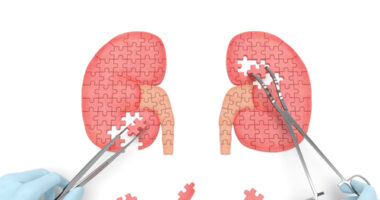Alport Patients Should be Checked for Eye Condition Keratoconus, Case Study Suggests

The eye condition keratoconus — when the cornea thins out and bulges like a cone — can occur in people with Alport syndrome, according to a new case report. Therefore, the condition should be considered when assessing the eye health of these patients, researchers say.
Their report, titled “Keratoconus in a patient with Alport syndrome: A case report,” was published in the World Journal of Clinical Cases.
Cataracts, anterior lenticonus, and fleck retinopathy are the most common eye conditions in Alport syndrome. Keratoconus, however, has not been frequently reported in people with this syndrome — in fact, it has been mentioned in one previous study, which reported that keratoconus occurred in three out of 45 people (6.7%) with Alport syndrome.
Keratoconus is characterized by the thinning and “bulging” shape of the cornea (the front part of the eye) which can result in vision impairment.
The patient detailed in the case report was 52 years old, female, and had been diagnosed with Alport syndrome two years before arriving at the study authors’ ophthalmology clinic with complaints of progressive vision loss and excessive tearing. The patient was being seen separately by a nephrologist, who deemed the kidney-related aspects of the disease to be stable at that time.
An eye examination was done on the patient, with the most notable findings coming from a keratometry, which measures the curvature of the cornea in diopters (D). In general, a keratometry measurement above 47 or 48 D is considered an indication of keratoconus.
Initially, the keratometry results were 47.9 D in the patient’s right eye and 48.3 D in the left. At a follow-up examination done two months later, these values had increased to 48.1 D in the right eye and 48.5 D in the left eye, suggesting that the patient’s condition was worsening over time.
“Based on the Amsler-Krumeich Classification system, our patient was diagnosed with stage 2 keratoconus, with signs of progression over two months, including further corneal thinning and increased steepening of the disease,” the authors wrote.
Since her keratoconus is currently quite mild, the patient was advised to continue wearing glasses and to avoid eye rubbing, which may have been involved in the development of keratoconus (although the precise cause of the condition remain unclear).
The authors said that the patient’s condition is being monitored regularly at their ophthalmology clinic, and if it significantly worsens, surgical options (i.e. corneal transplantation) may be suggested.
“Although a rare presentation, concurrent Alport syndrome and keratoconus should be considered when reviewing the ocular health of Alport syndrome patients and appropriate management steps should be taken upon the diagnosis,” they said.







Leave a comment
Fill in the required fields to post. Your email address will not be published.